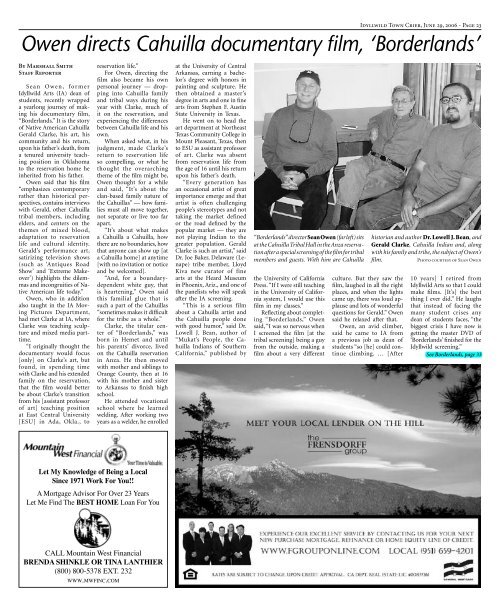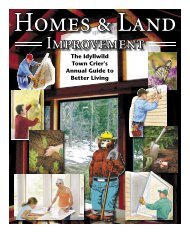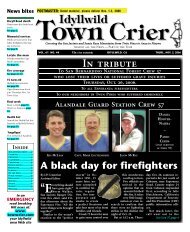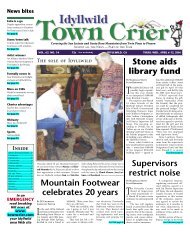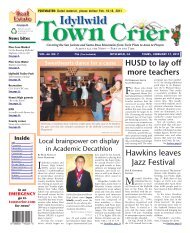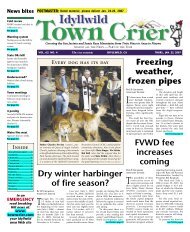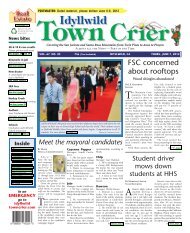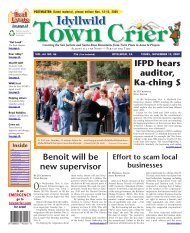real estate - Idyllwild Town Crier
real estate - Idyllwild Town Crier
real estate - Idyllwild Town Crier
You also want an ePaper? Increase the reach of your titles
YUMPU automatically turns print PDFs into web optimized ePapers that Google loves.
<strong>Idyllwild</strong> <strong>Town</strong> <strong>Crier</strong>, June 29, 2006 - Page 23<br />
Owen directs Cahuilla documentary film, ‘Borderlands’<br />
By Marshall Smith<br />
Staff Reporter<br />
S e a n Owen, former<br />
<strong>Idyllwild</strong> Arts (IA) dean of<br />
students, recently wrapped<br />
a yearlong journey of making<br />
his documentary film,<br />
“Borderlands.” It is the story<br />
of Native American Cahuilla<br />
Gerald Clarke, his art, his<br />
community and his return,<br />
upon his father’s death, from<br />
a tenured university teaching<br />
position in Oklahoma<br />
to the reservation home he<br />
inherited from his father.<br />
Owen said that his film<br />
“emphasizes contemporary<br />
rather than historical perspectives,<br />
contains interviews<br />
with Gerald, other Cahuilla<br />
tribal members, including<br />
elders, and centers on the<br />
themes of mixed blood,<br />
adaptation to reservation<br />
life and cultural identity.<br />
Gerald’s performance art,<br />
satirizing television shows<br />
(such as ‘Antiques Road<br />
Show’ and ‘Extreme Makeover’)<br />
highlights the dilemmas<br />
and incongruities of Native<br />
American life today.”<br />
Owen, who in addition<br />
also taught in the IA Moving<br />
Pictures Department,<br />
had met Clarke at IA, where<br />
Clarke was teaching sculpture<br />
and mixed media parttime.<br />
“I originally thought the<br />
documentary would focus<br />
[only] on Clarke’s art, but<br />
found, in spending time<br />
with Clarke and his extended<br />
family on the reservation,<br />
that the film would better<br />
be about Clarke’s transition<br />
from his [assistant professor<br />
of art] teaching position<br />
at East Central University<br />
[ESU] in Ada, Okla., to<br />
reservation life.”<br />
For Owen, directing the<br />
film also became his own<br />
personal journey — dropping<br />
into Cahuilla family<br />
and tribal ways during his<br />
year with Clarke, much of<br />
it on the reservation, and<br />
experiencing the differences<br />
between Cahuilla life and his<br />
own.<br />
When asked what, in his<br />
judgment, made Clarke’s<br />
return to reservation life<br />
so compelling, or what he<br />
thought the overarching<br />
theme of the film might be,<br />
Owen thought for a while<br />
and said, “It’s about the<br />
clan-based family nature of<br />
the Cahuillas” — how families<br />
must all move together,<br />
not separate or live too far<br />
apart.<br />
“It’s about what makes<br />
a Cahuilla a Cahuilla, how<br />
there are no boundaries, how<br />
that anyone can show up [at<br />
a Cahuilla home] at anytime<br />
[with no invitation or notice<br />
and be welcomed].<br />
“And, for a boundarydependent<br />
white guy, that<br />
is heartening.” Owen said<br />
this familial glue that is<br />
such a part of the Cahuillas<br />
“sometimes makes it difficult<br />
for the tribe as a whole.”<br />
Clarke, the titular center<br />
of “Borderlands,” was<br />
born in Hemet and until<br />
his parents’ divorce, lived<br />
on the Cahuilla reservation<br />
in Anza. He then moved<br />
with mother and siblings to<br />
Orange County, then at 16<br />
with his mother and sister<br />
to Arkansas to finish high<br />
school.<br />
He attended vocational<br />
school where he learned<br />
welding. After working two<br />
years as a welder, he enrolled<br />
at the University of Central<br />
Arkansas, earning a bachelor’s<br />
degree with honors in<br />
painting and sculpture. He<br />
then obtained a master’s<br />
degree in arts and one in fine<br />
arts from Stephen F. Austin<br />
State University in Texas.<br />
He went on to head the<br />
art department at Northeast<br />
Texas Community College in<br />
Mount Pleasant, Texas, then<br />
to ESU as assistant professor<br />
of art. Clarke was absent<br />
from reservation life from<br />
the age of 16 until his return<br />
upon his father’s death.<br />
“Every generation has<br />
an occasional artist of great<br />
importance emerge and that<br />
artist is often challenging<br />
people’s stereotypes and not<br />
taking the market defined<br />
or the road defined by the<br />
popular market — they are<br />
not playing Indian to the<br />
greater population. Gerald<br />
Clarke is such an artist,” said<br />
Dr. Joe Baker, Delaware (Lenape)<br />
tribe member, Lloyd<br />
Kiva new curator of fine<br />
arts at the Heard Museum<br />
in Phoenix, Ariz., and one of<br />
the panelists who will speak<br />
after the IA screening.<br />
“This is a serious film<br />
about a Cahuilla artist and<br />
the Cahuilla people done<br />
with good humor,” said Dr.<br />
Lowell J. Bean, author of<br />
“Mukat’s People, the Cahuilla<br />
Indians of Southern<br />
California,” published by<br />
“Borderlands” director Sean Owen (far left) sits<br />
at the Cahuilla Tribal Hall in the Anza reservation<br />
after a special screening of the film for tribal<br />
members and guests. With him are Cahuilla<br />
the University of California<br />
Press. “If I were still teaching<br />
in the University of California<br />
system, I would use this<br />
film in my classes.”<br />
Reflecting about completing<br />
“Borderlands,” Owen<br />
said, “I was so nervous when<br />
I screened the film [at the<br />
tribal screening] being a guy<br />
from the outside, making a<br />
film about a very different<br />
culture. But they saw the<br />
film, laughed in all the right<br />
places, and when the lights<br />
came up, there was loud applause<br />
and lots of wonderful<br />
questions for Gerald.” Owen<br />
said he relaxed after that.<br />
Owen, an avid climber,<br />
said he came to IA from<br />
a previous job as dean of<br />
students “so [he] could continue<br />
climbing. … [After<br />
historian and author Dr. Lowell J. Bean, and<br />
Gerald Clarke, Cahuilla Indian and, along<br />
with his family and tribe, the subject of Owen’s<br />
film.<br />
Photo courtesy of Sean Owen<br />
10 years] I retired from<br />
<strong>Idyllwild</strong> Arts so that I could<br />
make films. [It’s] the best<br />
thing I ever did.” He laughs<br />
that instead of facing the<br />
many student crises any<br />
dean of students faces, “the<br />
biggest crisis I have now is<br />
getting the master DVD of<br />
‘Borderlands’ finished for the<br />
<strong>Idyllwild</strong> screening.”<br />
See Borderlands, page 33<br />
Let My Knowledge of Being a Local<br />
Since 1971 Work For You!!<br />
A Mortgage Advisor For Over 23 Years<br />
Let Me Find The BEST HOME Loan For You<br />
CALL Mountain West Financial<br />
BRENDA SHINKLE OR TINA LANTHIER<br />
(800) 800-5378 EXT. 232<br />
WWW.MWFINC.COM


